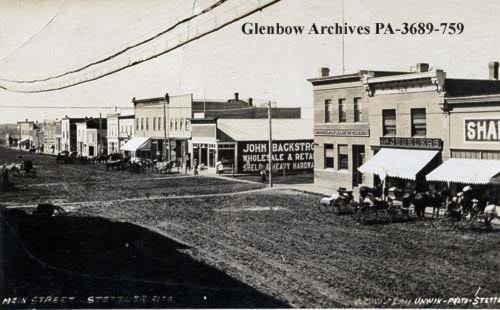By Carson Ellis
One name that cannot go uncredited when it comes to the early days of construction in both the Town and County of Stettler is Swedish Immigrant John Backstrom.
He was born in 1858 in Ostmark, Varmlands Lan, Sweden.
In 1865, the Backstrom family which was comprised of Father Bengt, Mother Annie, and three children, immigrated to Swan Lake, Minnesota. While in Minnesota, two more children were brought into the Backstrom family. At some point between 1880 and 1885, the family again moved, this time settling in Devils Lake, North Dakota.
This would not be the last time the family was on the move.
In 1904, the Backstrom clan came to what would soon be considered the Stettler area.
John and his wife Carolina are noted as having homesteaded on the SE & SW 28-38-20-W4.
John was a talented contractor and carpenter. He built a hardware store on the lot where Cabinet of Curiosities now stands.
He was assisted with his contracting work by his brother Nels and his brother-in-law who was a plasterer. The Ransom school, which was opened in 1906, and was roughly three miles southwest of the Stettler Museum, was one of their buildings.
Another Backstrom project was the town’s first official school which was built in town in 1907 and would later become the Stettler courthouse. Both buildings currently sit at the Museum grounds.
Also, if you’re ever out in the splendid community of Big Valley, have a wander over to the ruins of the Roundhouse. This would be another project that John and his associates were a part of.
One building that John and his brother Nels were a key part of, but is sadly no longer with us, would be the second church to be built in Stettler and originally sat where the United Church now sits.
St. David’s Lutheran Church was constructed in 1906.
It was approximately 28 ft. wide, and 40 ft. long, and had 10 ft. walls which would mean the steep pitched roof had a peak of roughly 24 ft. high.
The church’s entry was part of the eight ft. by eight ft. bell tower, and extended up to about 32 ft.
Mr. Alfred Erichsen, who wrote a fantastic book on the Lutheran community of Stettler, notes that the height of the belfry and steeple came out to 60 ft. and probably doubled the cost of the building, but that Mr. Backstrom was determined to do it right.
Churches were often built as landmarks, and the Backstroms had most certainly seen landmark churches in North Dakota and Minnesota, so they were determined to build St. David’s as a landmark.
The Backstrom family would comprise a large part of the early Lutheran community. However other names in the congregation would include Olsons, Borglands and Carlsons.
This building would change hands a few times over the years.
When the Swedish Lutheran congregation collapsed sometime around 1912, the property was sold to the Nazarenes. This would be their home for a few years before what can only be described as a bout of ‘church hot potato’ where the building would change hands between the Nazarenes and the United Congregation.
Very shortly afterwards, it would change hands again between the United Congregation and the Emmanuel Church of Botha, who were looking for a home in Stettler.
The legacy of John Backstrom has remained fairly well intact over the years.
Which is impressive if you consider some of the building he is known for were largely comprised of wood. The Ransom school operated until its closure in 1944. It would be sold roughly 10 years later, to the Ransom community who would later restore it, and the Stettler and District Museum would turn it into one of their well-preserved pioneer buildings.
The first official schoolhouse would quickly become too small, and a new brick structure would be built. Fortunately, the Alberta government would convert the building into a courthouse, and it would continue to be a main point in the community and still stands today. The Roundhouse still stands, although not as intact as other Backstrom buildings.
Although the Lutheran church that he built would eventually be partially dismantled in 1963 before being completely destroyed some time later, he would not live to see it.
John Backstrom would pass away in April of 1927.
In his obituary, it was noted that he became ill at his farm on the shores of Buffalo Lake which he had purchased after selling his hardware business.
He would become sick with stomach troubles on Saturday and pass away on Sunday. The funeral for the 69-year-old pioneer would be held that Wednesday in the Stettler United Church. The funeral services were likely held in the former Methodist Church which sat on the southwest intersection of Alberta (50th) Ave. and Taylor (51st) St. and had been built just shortly before the Swedish Lutheran Church.
When the Methodists and the Presbyterians merged to form the United Congregation, this had been their home.
The United Church would purchase the Backstrom-built landmark from the Nazarenes in May of that same year. I can’t help but wonder if John had been a part of the process, or if perhaps he wasn’t that involved in church business. Will have to just leave it all up to speculation I suppose.
In June of 1923, the Lutheran Congregation of Botha would purchase the building, and relocate it to the southwest corner of Main Street, and Hall (48th) Ave.
